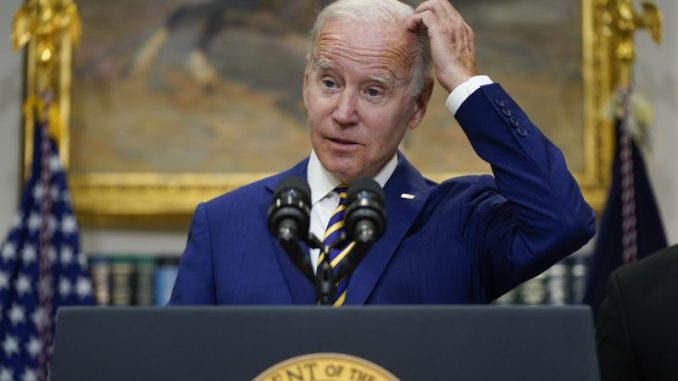

President Joe Biden speaks about student loan debt forgiveness in the Roosevelt Room of the White House, Wednesday, Aug. 24, 2022, in Washington. (AP Photo/Evan Vucci)
OAN Newsroom
UPDATED 12:50 PM PT – Monday, August 29, 2022
President Joe Biden’s Student Loan Forgiveness Plan continues to be polarizing to all, even to individuals within his own party. Progressives rejoiced at Joe Biden’s student loan forgiveness announcement while vulnerable Democrats broke with the President’s decision.
Senator Bernie Sanders (D-VT.) praised the move that a Penn Wharton model estimated would cost taxpayers an excess of one trillion dollars over the next decade.
If SoFI, a student loan refinancing company, could give its CEO a 92% raise last year paying him a grand total of $103 million in compensation and spend $625 million to put its name on the LA Rams football stadium, you know what President Biden can do? Cancel all student debt.
— Bernie Sanders (@BernieSanders) August 23, 2022
However , during an interview on ABC this week, the Vermont Senator said the President’s plan didn’t go far enough and he called for further government subsidization of the education system.
“We have got to really be thinking about higher education in general,” Sanders said. “And, in my view, at a time when hundreds of thousands of bright young people can’t even afford to go to college – if we’re going to be competitive in a global economy – we need to make public colleges and universities tuition-free.”
Fellow Progressive Elizabeth Warren (D-Mass.) echoed Sanders’s sentiments. While speaking with CNN’s Dana Bash, Warren expressed that she believed the debt transference was justified because of the surging cost of higher education in the United States. However, Warren’s statements failed to address why universities demand such a high price tag.
“Our public education system is no longer creating opportunities for kids like me and other kids whose families can’t afford to write a check,” Warren said. “Instead, we’re saying to these young people ‘you’ve got to get an education but we are gonna wrap the chains of debt around you.’”
A direct correlation can be drawn between federal subsidization of student loans and tuition costs. The 1992 Higher Education Reauthorization Act ensured loans directly from the Department of Education to borrowers. Between 1993 and 2006 tuition at public universities rose 47-percent.
Not all Democrats are supportive of further government investments into student debt. A number of Democrats in swing state races, such as Representatives Tim Ryan (D-Ohio) and Sharice Davids (D-Kan.) as well as Senator Catherine Cortez-Masto (D-Nev.) have come out in opposition to the bill. The lawmakers have claimed that the move will help well-to-do Americans while failing to address the cost of education.
Former Treasury Secretary Lawrence Summers, who served under both President Obama and President Clinton, has argued that forgiveness will encourage institutions to raise tuition.
“I did not support large-scale student debt relief,” says @LHSummers in regards to President Biden’s recent decision.
“It does add to demand, which does increase inflationary pressures, but that’s something that the Fed should be able to offset” https://t.co/5z9NOOERJl pic.twitter.com/DyX1v6AdmU
— Bloomberg TV (@BloombergTV) August 26, 2022
Former Top Advisor to President Bill Clinton, Paul Begala, expressed outrage that the White House would unfairly distribute funds into the hands of the educated at the expense of the lower class.
“Why is my party doing with this?” Begala questioned. “They’re disadvantaging. I think they’re not helping people we’re here to help which is poor people and underprivileged communities and they’re not helping their politicians who are running.”
Currently, 87-percent of American adults do not have student loans. 58-percent of all student debt is held by the wealthiest 40-percent of Americans.
The Biden administration has defended student loan forgiveness by conflating it with Paycheck Protection Program loans, which the government dispersed to employers in order to retain their employees after forcing them to shut down during the COVID-19 lockdowns.

